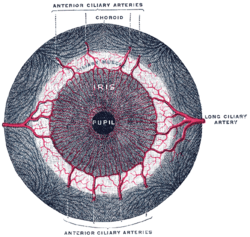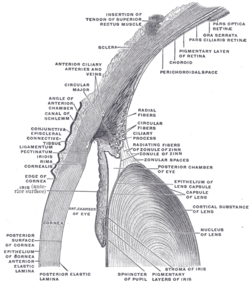Iris sphincter muscle
| Iris sphincter muscle | |
|---|---|

Iris, front view. (Muscle visible but not labeled.)
|
|

The upper half of a sagittal section through the front of the eyeball. ("Sphincter of pupil" labeled near bottom-center.)
|
|
| Details | |
| Origin | encircles iris |
| Insertion | encircles iris |
| Artery | long posterior ciliary arteries |
| Nerve | short ciliary nerves |
| Actions | constricts pupil |
| Antagonist | iris dilator muscle |
| Identifiers | |
| Latin | Musculus sphincter pupillae |
| Dorlands /Elsevier |
m_22/12550831 |
| TA | A15.2.03.029 |
| FMA | 49157 |
|
Anatomical terms of muscle
[]
|
|
The iris sphincter muscle (pupillary sphincter, pupillary constrictor, circular muscle of iris, circular fibers) is a muscle in the part of the eye called the iris. It encircles the pupil of the iris, appropriate to its function as a constrictor of the pupil.
It is found in vertebrates and some cephalopods.
Initially, all the myocytes are of the smooth muscle type but, later in life, most cells are of the striated muscle type.
Its dimensions are about 0.75 mm wide by 0.15 mm thick.
In humans, it functions to constrict the pupil in bright light (pupillary light reflex) or during accommodation.
It is controlled by parasympathetic fibers that originate from the Edinger-Westphal nucleus, travel along the oculomotor nerve (CN III), synapse in the ciliary ganglion, and then enter the eye via the short ciliary nerves.. The short ciliary nerves then run forward and pierce the sclera at the back of the eye, traveling between the sclera and the choroid to innervate the iris sphincter muscle.
...
Wikipedia
